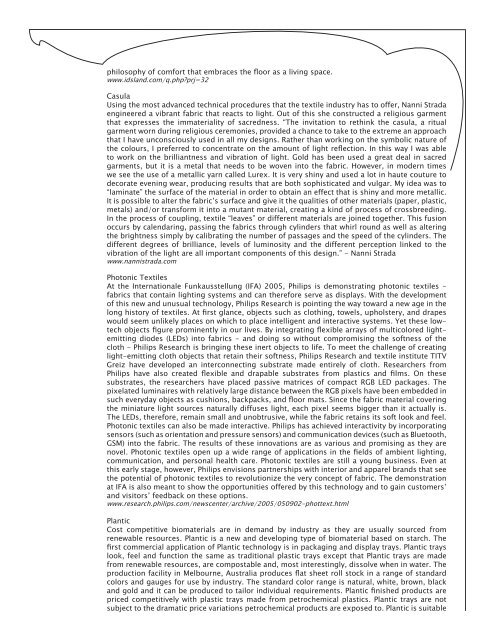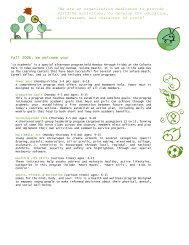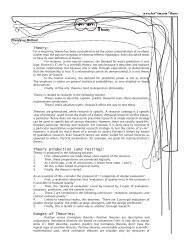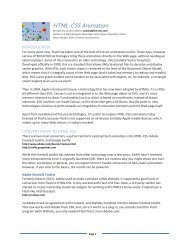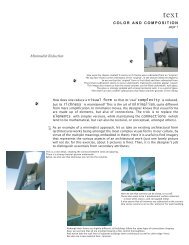ULTRAPERFORMING Beams/ Columns Doors ... - fen-om data
ULTRAPERFORMING Beams/ Columns Doors ... - fen-om data
ULTRAPERFORMING Beams/ Columns Doors ... - fen-om data
Create successful ePaper yourself
Turn your PDF publications into a flip-book with our unique Google optimized e-Paper software.
philosophy of c<strong>om</strong>fort that embraces the floor as a living space.<br />
www.idsland.c<strong>om</strong>/q.php?prj=32<br />
Casula<br />
Using the most advanced technical procedures that the textile industry has to offer, Nanni Strada<br />
engineered a vibrant fabric that reacts to light. Out of this she constructed a religious garment<br />
that expresses the immateriality of sacredness. “The invitation to rethink the casula, a ritual<br />
garment worn during religious ceremonies, provided a chance to take to the extreme an approach<br />
that I have unconsciously used in all my designs. Rather than working on the symbolic nature of<br />
the colours, I preferred to concentrate on the amount of light reflection. In this way I was able<br />
to work on the brilliantness and vibration of light. Gold has been used a great deal in sacred<br />
garments, but it is a metal that needs to be woven into the fabric. However, in modern times<br />
we see the use of a metallic yarn called Lurex. It is very shiny and used a lot in haute couture to<br />
decorate evening wear, producing results that are both sophisticated and vulgar. My idea was to<br />
“laminate” the surface of the material in order to obtain an effect that is shiny and more metallic.<br />
It is possible to alter the fabric’s surface and give it the qualities of other materials (paper, plastic,<br />
metals) and/or transform it into a mutant material, creating a kind of process of crossbreeding.<br />
In the process of coupling, textile “leaves” or different materials are joined together. This fusion<br />
occurs by calendaring, passing the fabrics through cylinders that whirl round as well as altering<br />
the brightness simply by calibrating the number of passages and the speed of the cylinders. The<br />
different degrees of brilliance, levels of luminosity and the different perception linked to the<br />
vibration of the light are all important c<strong>om</strong>ponents of this design.” - Nanni Strada<br />
www.nannistrada.c<strong>om</strong><br />
Photonic Textiles<br />
At the Internationale Funkausstellung (IFA) 2005, Philips is demonstrating photonic textiles -<br />
fabrics that contain lighting systems and can therefore serve as displays. With the development<br />
of this new and unusual technology, Philips Research is pointing the way toward a new age in the<br />
long history of textiles. At first glance, objects such as clothing, towels, upholstery, and drapes<br />
would seem unlikely places on which to place intelligent and interactive systems. Yet these lowtech<br />
objects figure pr<strong>om</strong>inently in our lives. By integrating flexible arrays of multicolored lightemitting<br />
diodes (LEDs) into fabrics - and doing so without c<strong>om</strong>pr<strong>om</strong>ising the softness of the<br />
cloth - Philips Research is bringing these inert objects to life. To meet the challenge of creating<br />
light-emitting cloth objects that retain their softness, Philips Research and textile institute TITV<br />
Greiz have developed an interconnecting substrate made entirely of cloth. Researchers fr<strong>om</strong><br />
Philips have also created flexible and drapable substrates fr<strong>om</strong> plastics and films. On these<br />
substrates, the researchers have placed passive matrices of c<strong>om</strong>pact RGB LED packages. The<br />
pixelated luminaires with relatively large distance between the RGB pixels have been embedded in<br />
such everyday objects as cushions, backpacks, and floor mats. Since the fabric material covering<br />
the miniature light sources naturally diffuses light, each pixel seems bigger than it actually is.<br />
The LEDs, therefore, remain small and unobtrusive, while the fabric retains its soft look and feel.<br />
Photonic textiles can also be made interactive. Philips has achieved interactivity by incorporating<br />
sensors (such as orientation and pressure sensors) and c<strong>om</strong>munication devices (such as Bluetooth,<br />
GSM) into the fabric. The results of these innovations are as various and pr<strong>om</strong>ising as they are<br />
novel. Photonic textiles open up a wide range of applications in the fields of ambient lighting,<br />
c<strong>om</strong>munication, and personal health care. Photonic textiles are still a young business. Even at<br />
this early stage, however, Philips envisions partnerships with interior and apparel brands that see<br />
the potential of photonic textiles to revolutionize the very concept of fabric. The demonstration<br />
at IFA is also meant to show the opportunities offered by this technology and to gain cust<strong>om</strong>ers’<br />
and visitors’ feedback on these options.<br />
www.research.philips.c<strong>om</strong>/newscenter/archive/2005/050902-phottext.html<br />
Plantic<br />
Cost c<strong>om</strong>petitive bi<strong>om</strong>aterials are in demand by industry as they are usually sourced fr<strong>om</strong><br />
renewable resources. Plantic is a new and developing type of bi<strong>om</strong>aterial based on starch. The<br />
first c<strong>om</strong>mercial application of Plantic technology is in packaging and display trays. Plantic trays<br />
look, feel and function the same as traditional plastic trays except that Plantic trays are made<br />
fr<strong>om</strong> renewable resources, are c<strong>om</strong>postable and, most interestingly, dissolve when in water. The<br />
production facility in Melbourne, Australia produces flat sheet roll stock in a range of standard<br />
colors and gauges for use by industry. The standard color range is natural, white, brown, black<br />
and gold and it can be produced to tailor individual requirements. Plantic finished products are<br />
priced c<strong>om</strong>petitively with plastic trays made fr<strong>om</strong> petrochemical plastics. Plantic trays are not<br />
subject to the dramatic price variations petrochemical products are exposed to. Plantic is suitable


